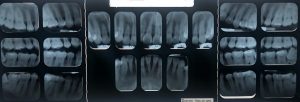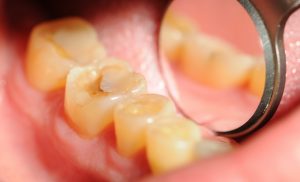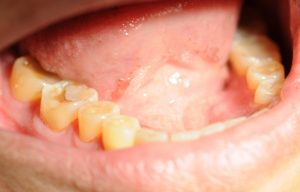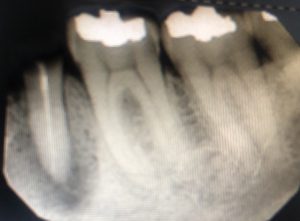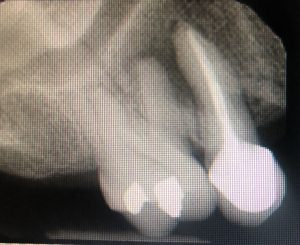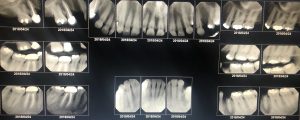Case 1
L.R. 28 year old male. Hispanic. Non-smoker. ASA I. Last oral hygiene services were provided approximately 10 years ago. Patient presented with generalized heavy deposits and periodontal disease. Radiographs revealed the severity of bone loss on mandibular anterior teeth and placed him under a Type III periodontal disease. Patient was treated during freshman and senior semesters. Severe bleeding upon probing and exploring. Pocket measurements were mostly 4-6 mm with generalized recession. Teeth # 24-25 had a grade two mobility. Tooth #25 presented with mucogingival involvement. Patient was very sensitive. Dentist provided block anesthesia for patient’s comfort to proceed with treatment. Heavy deposits were tenacious and very difficult to remove. During my senior year, I was able to place arestin. I chose this patient because bacteria was causing the severity of bone loss. Patient’s results were successful. Probing depths of 6 mm improved to 2-3 mm. Gingiva was pink, firm, resilient and snuggling the teeth surfaces. Patient ended up being a light case value from heavy case. Dental home care improved and totally changed his oral condition. Referral was provided to patient for periodontal disease.
Case 2
I.R. 41 year old female. Hispanic. Non-smoker. ASA I. During the intra-oral examination, maxillary and mandibular bilateral tori were noticed. Patient presents with generalized severe erosion on full dentition. Bilateral class of occlusion I with 3 mm overjet and 20% overbite. Patient has dentin hypersensitivity. Minimal bleeding upon probing. Generalized 2-3 mm sulcus depths. Gingival margin is pink but rolled in contour due to minimal plaque accumulated. No calculus present. During patient education, I reinforced the proper flossing technique. Advised patient to use Sensodyne toothpaste. Patient’s treatment was complete within one visit. Ultrasonic inserts was impossible to use on this patient due to her dentinal hypersensitivity. Hand scaling instrumentation was provided for completion of treatment. I was not able to polish her teeth because patient was not comfortable due to her sensivity. 5% Sodium Fluoride Varnish was also provided to patient.
Case 3
A.R. 41 year old female. Hispanic. Non-smoker. ASA II. Patient presents with high blood pressure. She is currently taking medications such as Amlodipine 10 mg daily. Blood pressure readings were 140/80. Patient stated that she has been under medication for hypertension for about 2 years. Past dental history consisted on not seeing a dentist for about 4 years. Patient presents with asymptomatic bilateral TMJ crepitation. According to dental charting, patient is missing teeth #1, 2, 5, 12 and 16. She stated that these teeth required extractions due to cavities. Fractured tooth #20. Bilateral class of occlusion I with 7 mm overjet and 5% overbite. Diastema present between maxillary anterior teeth. Moderate bleeding upon probing. Measurements consisted on 4-6 mm pocket depths located inter proximally on posterior teeth. Generalized red, rolled in contour, and inflamed gingival margin. Localized deposits of calculus present on mandibular anterior teeth and posterior teeth. Generalized plaque observed on the cervical third of the teeth. Patient was classified as a medium case value due to localized calculus deposits. During the first visit, patient was exposed to a FMS. Taking the radiographs was challenging due her narrow maxillary and mandibular arches. Fractured tooth #20 with a root canal is observed on the x-rays. A 3 mm round radiolucency presents on the apex of tooth #20. Also, tooth #4 was mobile and depressible. Periapical pathology was seen on the x-ray. For home care, tooth-brushing technique was introduced and taught to patient. Scaled teeth # 6-8 with hand instruments. During the second visit, an intra-oral examination was performed to evaluate gingival tissue. Periapical abscess is present on the attached gingiva by tooth #20. This abscess was not present during the first visit. Patient was feeling a little pain on that tooth. For home care, I showed patient how to floss properly and provided soft picks for the diastema on the maxillary anterior teeth. Scaled all quadrants with ultrasonic and hand instruments avoiding tooth #20 due to abscess present. Polished full dentition and provided 5% Sodium Fluoride Varnish. Faculty and I explained to patient about her oral condition and provided a copy of x-rays and referral for evaluation of these affected areas.

